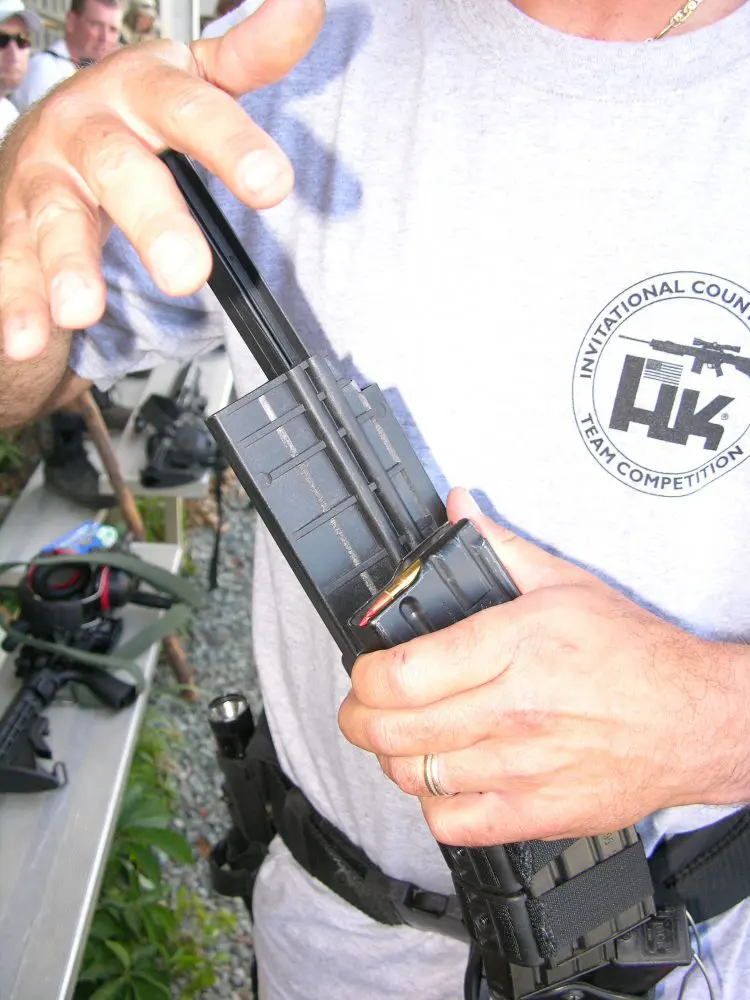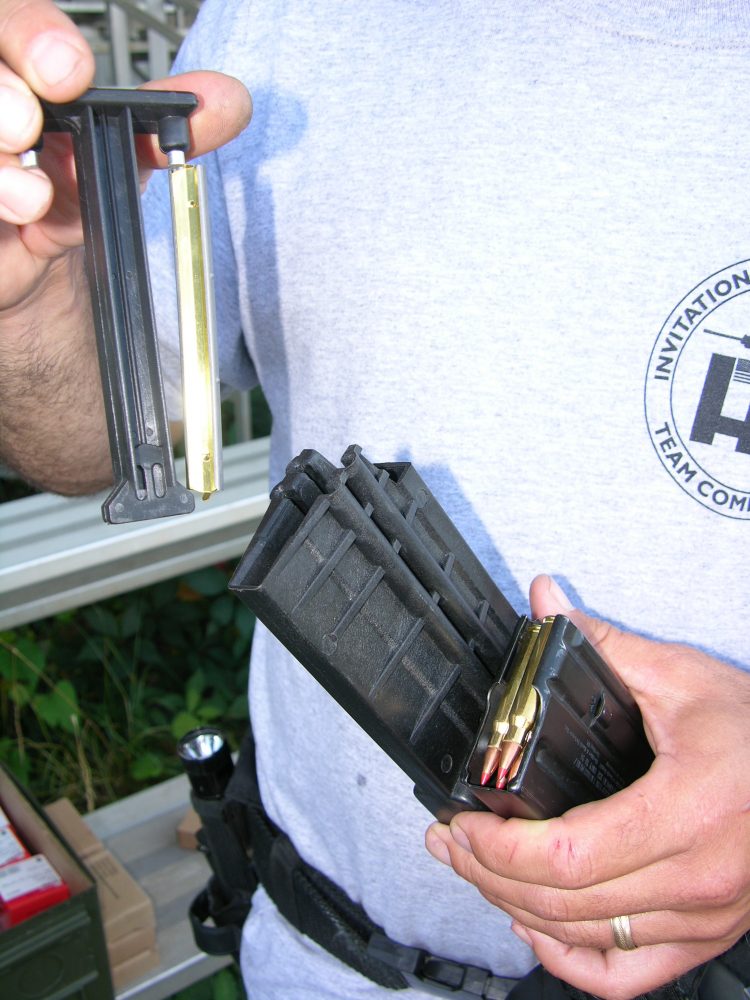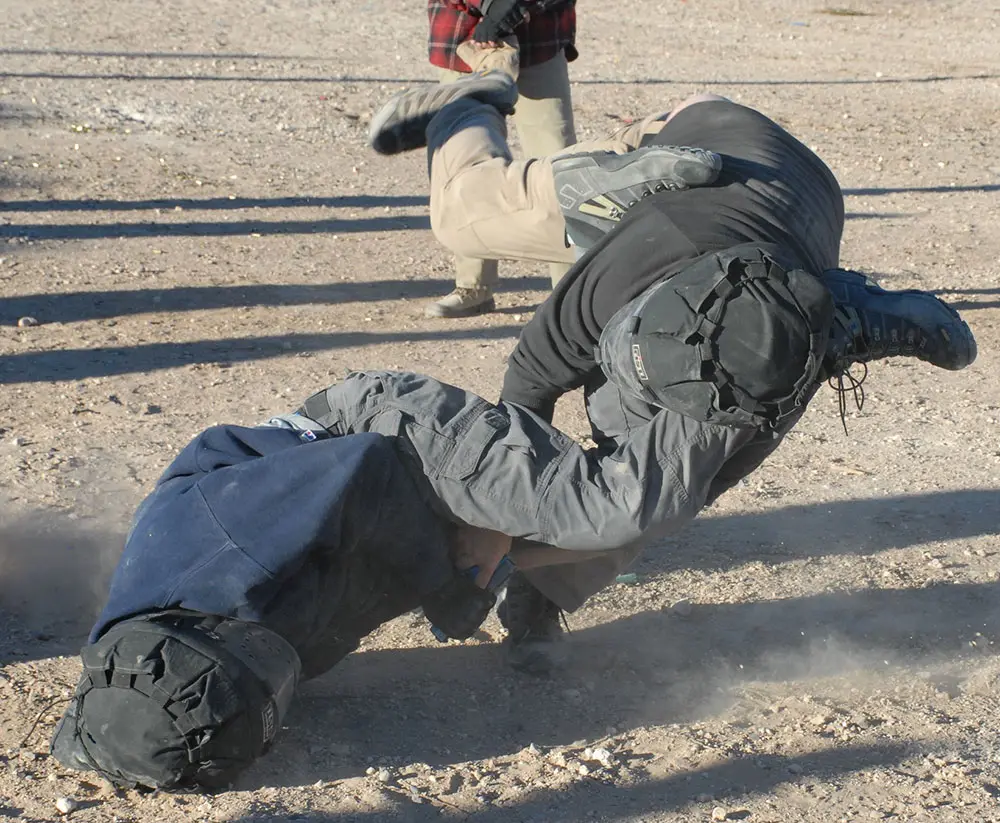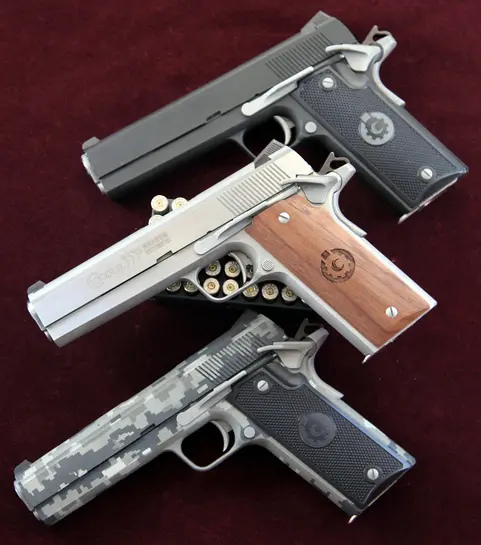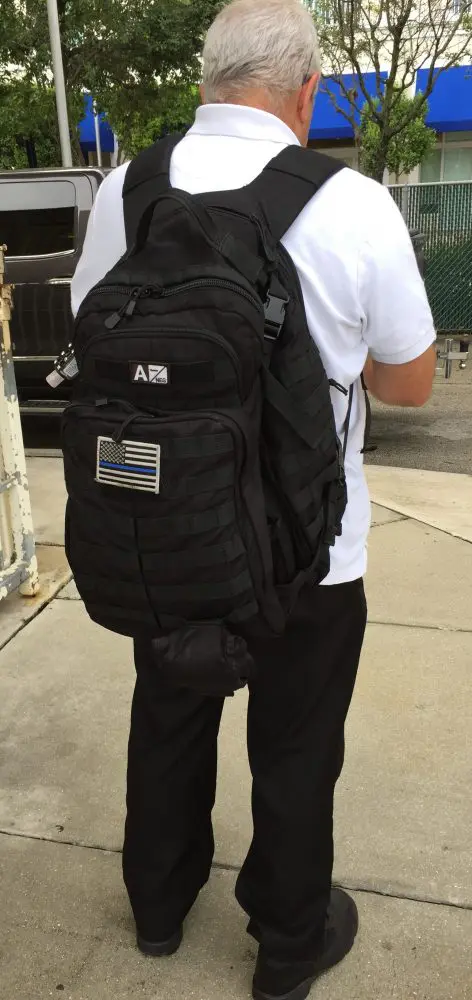The Personal Loader. The plunger is extended to open a port on the right side of the unit. To load, simply place five rounds into the port and depress the plunger.
Magazines are the devices that keep your firestick fed. Unlike what we see on the big screens, magazines do not come from the factory pre-loaded with an inexhaustible supply of cartridges. Unlike the fantasy of some magazine writers, they don’t come out of “supply” already loaded and ready to shoot. You have to load them, and the amount of ammunition they hold is finite. A fact of life is that you need multiple magazines as well as the means to charge that magazine at regular intervals—if you want to keep in the fight.
The U.S. military (as well as some others) packages their 5.56x45mm M855 Ball combat ammunition in ten-round clips (commonly “stripper clips”). These clips are made of Parkerized steel with a brass-tensioning device. These clips are loaded into four pocket bandoleers (the so-called M8 Bandoleer), with three clips being inserted into a cardboard sleeve and those 30 rounds placed in each bandoleer pocket. With each bandoleer is a stamped metal charging guide (commonly called a speed or speedy loader), which acts as an interface between the magazine and the clip. The charger is pressed onto the rear of the magazine, and the clip is inserted into the charger. Pressing down on the cartridges will cause them to enter the magazine. Remove the clip and repeat as necessary.
A cautionary note here: While the capacity of a thirty-round magazine is in fact thirty rounds, load only twenty-eight in them. The reason is simple: some magazines, when fully loaded, will not lock into the mag well if the bolt is forward. By downloading two rounds you can be sure that you can lock in any mag (remember- Push Pull!) whether the bolt is forward or not. At any given carbine class I will see thirty to fifty instances of a shooter failing to lock the mag in the well. The mag then falls out of the carbine. The shooter gets vapor lock, spends a great amount of time trying to force something that won’t happen and fails to transition to his pistol. Even if he does correctly transition to his pistol, the entire line must wait while the errant shooter (hopefully) gets himself squared away.
The Speed Loader: The unit is placed over the magazine (note that here two H&K magazines are attached to each other). The plunger is pushed down, stripping the rounds off the clip and pushing them into the magazine.
Multiply this wasted time by 30-50 and you can begin to understand why the class isn’t shooting as much as they should, and why everyone dislikes you.
Don’t be stupid. Be positive in your mindset and actions. Remember, in a gunfight you have the rest of your life to get things right.
Bandoleers are loaded into a steel ammunition can, and two cans are packaged into a wood crate.
The system has been with us for about forty years, and works—after a fashion. The charger is casualty-producing—lacerated hands are common.
Some M855 ammunition used for training is packed in ten-round clips but in a cardboard, rather than steel, box. There are no chargers in the box. Some useless pencil-necked geek made the decision to save money by not including the charging guides. Of course, the aforementioned pencil-necked geek never had to consider the amount of training time wasted as the troops have to declip the ammunition in order to load the magazines—why would that thought occur to him?
The excellent MK262 Mod1 ammunition is not clipped, rather it comes packaged in twenty or fifty round boxes.
Civilian ammunition also is packed in boxes, generally twenty rounds to the box. (Black Hills is packaged fifty rounds to the box.) In order to charge magazines, you need to load each round individually. This is a time consuming task—especially if you are going to a three to five day training course where you will be firing at least 300-500 rounds daily.
When you pull the plunger up, a magnet located on the top of the plunger will grab onto the clip, which can be easily discarded. You can load a magazine in thirty seconds or less, depending on your manual dexterity.
There are a variety of loading/unloading tools available for the masses. These tools reduce the time necessary to charge magazines—time better spent doing other things. Some work well and some don’t, and like everything else in the world you need to choose wisely.
Beta Company, manufacturers of the C-Mag, needed a way to efficiently load their 100-round magazines. They wound up with two—the Beta Personal Loader and the Beta Speed Loader.
The Beta Personal Loader (LCMP05; NSN 1005-01-363-0200) is made for loading loose rounds, making it especially useful for cops and civilians who get their ammo in twenty-round boxes. The Personal Loader is a plunger-type unit made of plastic. The body of the loader fits over the top of the magazine. Pulling the plunger up exposes a loading port on the “side” of the unit; insert no more than five loose rounds, and then depress the plunger. Repeat until the magazine is loaded to your satisfaction. The process takes somewhere between thirty to sixty seconds, depending on your dexterity.
The Beta Speed Loader (LCMS10; NSN 1005-01-363-0199) is designed to work with ten-round stripper clips and is thus more useful for the military or those who have ammunition pre-loaded on clips. To use the Speed Loader, place the loader over the top of the magazine. There is a small plunger that fits into slots at the middle of the loader. Remove the plunger and insert a stripper clip into its slot at the rear of the loader. Place the plunger back into its slot, and apply pressure downward. The plunger will strip the rounds from the clip and push them into the magazine. A magnet on the plunger will remove the empty clip from the loader on the up stroke. Viola! Repeat as necessary.
Loading a magazine with the Speed Loader takes about fifteen seconds.
The Beta Speed Loader will fit in the issue flash-bang pouch, keeping it handy.
Are these loaders perfect? No, certainly no more than anything else made by man. The edges around the base are sharper than I would like. A pass or two with Mr. Dremel will effectively bevel those edges until they no longer cause pain. But that is it.
The C-Mag loaders are inexpensive, simple and efficient. Both are available in the military system and are issue items to some units. They do an excellent job in loading magazines. If you want to unload the magazine, you’ll have to seek another method—pressing the trigger is my favorite way.
[Pat Rogers is a retired Chief Warrant Officer of Marines and a retired NYPD Sergeant. Pat is the owner of E.A.G. Inc., which provides services to various governmental organizations. He can be reached at [email protected]]
SOURCES:
The Beta Company
Dept. S.W.A.T.
2137B Flintstone Drive
Tucker, Georgia 30084
(800) 669-2382
www.betaco.com
Specialized Armament Warehouse (S.A.W.)
Dept. S.W.A.T.
P.O. Box 6310
Chandler, AZ 85246-6310
(480) 940-7397
www.sawlesales.com
